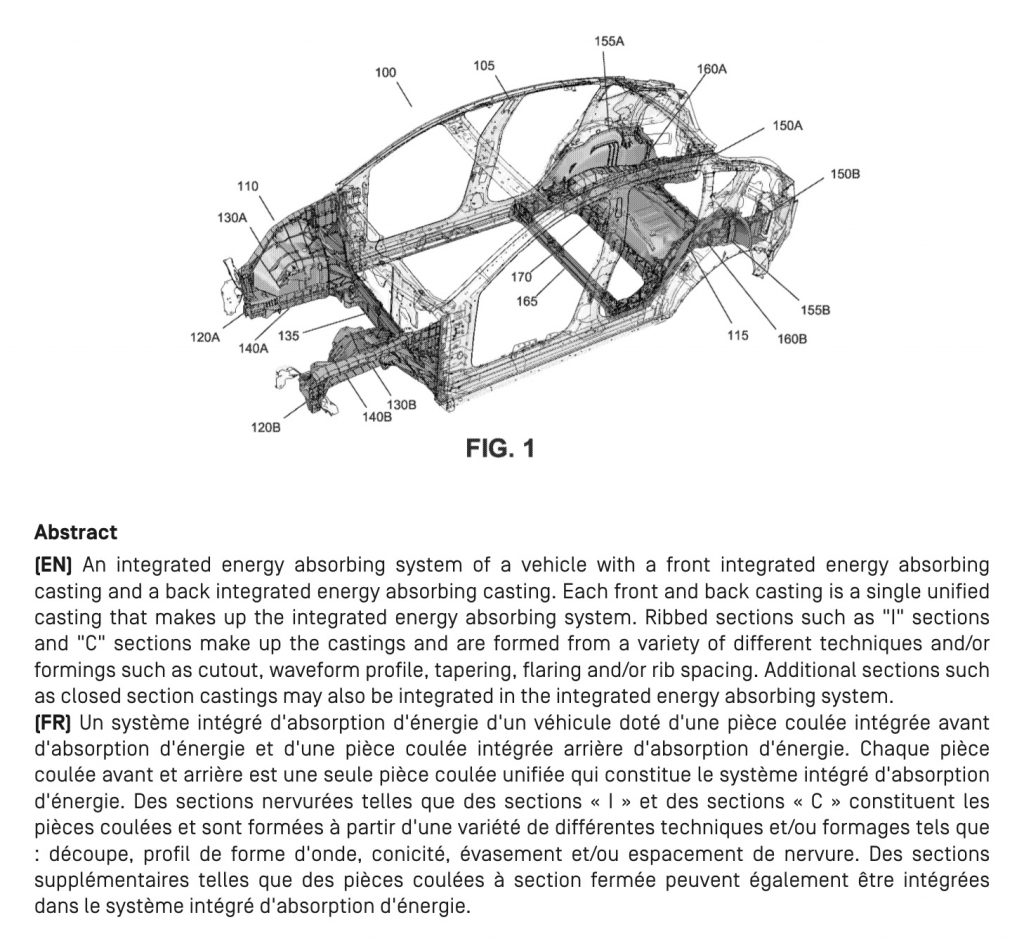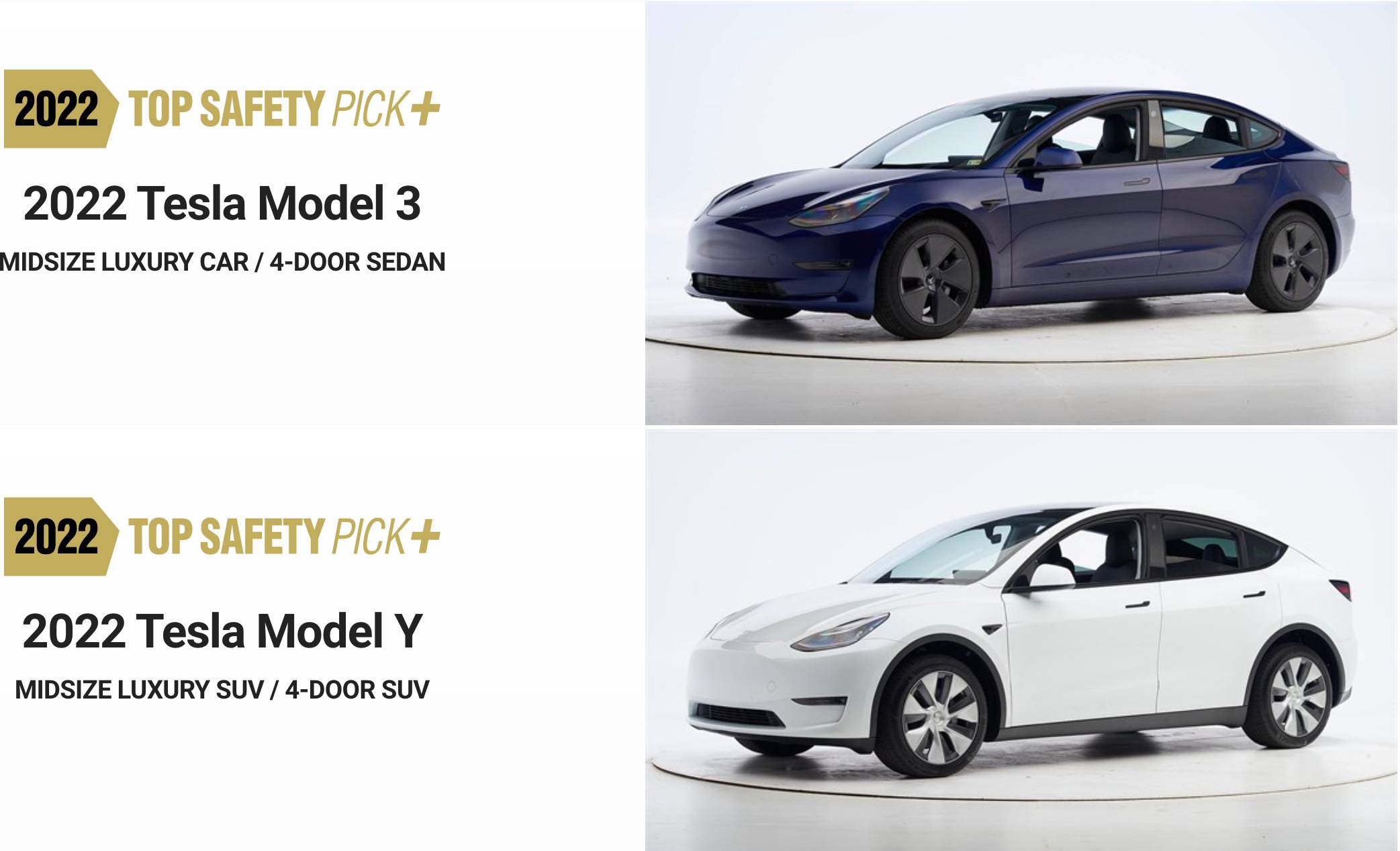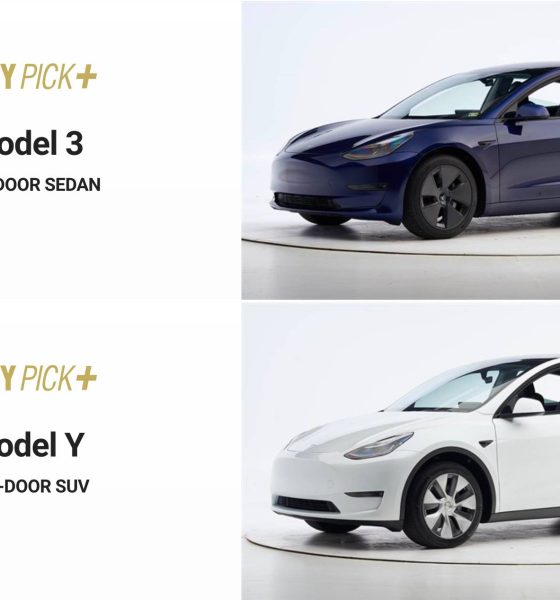The Tesla Model 3 and Model Y won the 2022 Top Safety Pick+ award from the Insurance Institute for Highway Safety (IIHS).
The IIHS tested a mid-range 2019 Tesla Model 3 and a Long Range 2021 Tesla Model Y for its 2022 Top Safety Pick+ award. The ratings Tesla received apply to the 2017-2022 Model 3 and 2020-2022 Model Y.
Breaking down the IIHS test, the Model 3 and the Model Y received “Good” ratings for crashworthiness, as seen below.

Both the Tesla Model 3 and Model Y received high marks in other parts of the IIHS tests as well. However, in the Crash Avoidance & Mitigation category, the Model 3 and Model Y received slightly different ratings. The Model 3 scored “Good” or “Superior” in all categories.
On the other hand, the Model Y was given a “Good” or “Acceptable” rating for headlights, with the IIHS noting that the score depended on the trim/option of the all-electric sedan. The safety agency reported that improved headlight offerings boosted more vehicles to win the top-tier Top Safety Pick+ award in 2022.
A recently published international Tesla patent suggests that Tesla’s vehicles will likely continue to achieve such high scores in evaluations such as the IIHS’ crashworthiness tests. The patent reveals how front and back megacastings act as an integrated energy absorbing system. Tesla China also provided an in-depth look into Giga Shanghai’s vehicles and how Tesla builds its cars to absorb impact.

Besides Tesla, 65 other vehicle models were recognized by the IIHS as 2022’s Top Safety Pick+ winners, and 36 models earned the lower-tier Top Safety Pick award. In total, the IIHS recognized 101 winners. In a press release, IIHS President David Harkey stated that while it is great to see numerous vehicles qualify for the Top Safety Pick+ award, it is time for the IIHS to roll out more stringent tests.
“We’re excited to see more vehicles on this list in 2022. Our awards make it easy for car buyers to find models that will protect them in a crash and increase the odds they’ll never be in one. By shooting for TOP SAFETY PICK+, automakers are showing that they’re committed to the same goal… Manufacturers deserve congratulations for the steady improvements they’ve made since we last updated our award requirements, but with U.S. traffic fatalities expected to exceed 40,000 people in 2021, it’s no time for anybody to rest on their laurels. A key reason vehicles have continued to get safer over the more than 25 years since the Institute began our ratings program is that we have never shied away from raising the bar. The high number of TOP SAFETY PICK+ winners shows that it’s time to push for additional changes,” Harkey said.
A recent IIHS study found that automatic emergency braking systems made no difference in pedestrian crashes that occurred at night. As a result, the safety agency decided to add a nighttime pedestrian crash prevention test held in complete darkness. Vehicles must earn an “Advanced” or “Superior” rating in the new nighttime test to win the Top Safety Pick+ award in 2023.
The new nighttime pedestrian crash prevention test will be an interesting evaluation for Tesla’s camera-based safety suite. During research tests on the upcoming nighttime pedestrian AEB evaluation, most of the test vehicles’ capabilities declined in the assessment conducted in complete darkness, except for one. The radar-only Volkswagen Taos maintained its performance rating in the nighttime pedestrian AEB evaluation test runs. However, the Taos was the worst performer during AEB daytime tests compared to the other vehicles in the nighttime AEB evaluation.
The Teslarati team would appreciate hearing from you. If you have any tips, reach out to me at maria@teslarati.com or via Twitter @Writer_01001101.

Elon Musk
Elon Musk and Tesla AI Director share insights after empty driver seat Robotaxi rides
The executives’ unoccupied tests hint at the rapid progress of Tesla’s unsupervised Robotaxi efforts.

Tesla CEO Elon Musk and AI Director Ashok Elluswamy celebrated Christmas Eve by sharing personal experiences with Robotaxi vehicles that had no safety monitor or occupant in the driver’s seat. Musk described the system’s “perfect driving” around Austin, while Elluswamy posted video from the back seat, calling it “an amazing experience.”
The executives’ unoccupied tests hint at the rapid progress of Tesla’s unsupervised Robotaxi efforts.
Elon and Ashok’s firsthand Robotaxi insights
Prior to Musk and the Tesla AI Director’s posts, sightings of unmanned Teslas navigating public roads were widely shared on social media. One such vehicle was spotted in Austin, Texas, which Elon Musk acknowleged by stating that “Testing is underway with no occupants in the car.”
Based on his Christmas Eve post, Musk seemed to have tested an unmanned Tesla himself. “A Tesla with no safety monitor in the car and me sitting in the passenger seat took me all around Austin on Sunday with perfect driving,” Musk wrote in his post.
Elluswamy responded with a 2-minute video showing himself in the rear of an unmanned Tesla. The video featured the vehicle’s empty front seats, as well as its smooth handling through real-world traffic. He captioned his video with the words, “It’s an amazing experience!”
Towards Unsupervised operations
During an xAI Hackathon earlier this month, Elon Musk mentioned that Tesla owed be removing Safety Monitors from its Robotaxis in Austin in just three weeks. “Unsupervised is pretty much solved at this point. So there will be Tesla Robotaxis operating in Austin with no one in them. Not even anyone in the passenger seat in about three weeks,” he said. Musk echoed similar estimates at the 2025 Annual Shareholder Meeting and the Q3 2025 earnings call.
Considering the insights that were posted Musk and Elluswamy, it does appear that Tesla is working hard towards operating its Robotaxis with no safety monitors. This is quite impressive considering that the service was launched just earlier this year.
Elon Musk
Starlink passes 9 million active customers just weeks after hitting 8 million
The milestone highlights the accelerating growth of Starlink, which has now been adding over 20,000 new users per day.

SpaceX’s Starlink satellite internet service has continued its rapid global expansion, surpassing 9 million active customers just weeks after crossing the 8 million mark.
The milestone highlights the accelerating growth of Starlink, which has now been adding over 20,000 new users per day.
9 million customers
In a post on X, SpaceX stated that Starlink now serves over 9 million active users across 155 countries, territories, and markets. The company reached 8 million customers in early November, meaning it added roughly 1 million subscribers in under seven weeks, or about 21,275 new users on average per day.
“Starlink is connecting more than 9M active customers with high-speed internet across 155 countries, territories, and many other markets,” Starlink wrote in a post on its official X account. SpaceX President Gwynne Shotwell also celebrated the milestone on X. “A huge thank you to all of our customers and congrats to the Starlink team for such an incredible product,” she wrote.
That growth rate reflects both rising demand for broadband in underserved regions and Starlink’s expanding satellite constellation, which now includes more than 9,000 low-Earth-orbit satellites designed to deliver high-speed, low-latency internet worldwide.
Starlink’s momentum
Starlink’s momentum has been building up. SpaceX reported 4.6 million Starlink customers in December 2024, followed by 7 million by August 2025, and 8 million customers in November. Independent data also suggests Starlink usage is rising sharply, with Cloudflare reporting that global web traffic from Starlink users more than doubled in 2025, as noted in an Insider report.
Starlink’s momentum is increasingly tied to SpaceX’s broader financial outlook. Elon Musk has said the satellite network is “by far” the company’s largest revenue driver, and reports suggest SpaceX may be positioning itself for an initial public offering as soon as next year, with valuations estimated as high as $1.5 trillion. Musk has also suggested in the past that Starlink could have its own IPO in the future.
News
NVIDIA Director of Robotics: Tesla FSD v14 is the first AI to pass the “Physical Turing Test”
After testing FSD v14, Fan stated that his experience with FSD felt magical at first, but it soon started to feel like a routine.

NVIDIA Director of Robotics Jim Fan has praised Tesla’s Full Self-Driving (Supervised) v14 as the first AI to pass what he described as a “Physical Turing Test.”
After testing FSD v14, Fan stated that his experience with FSD felt magical at first, but it soon started to feel like a routine. And just like smartphones today, removing it now would “actively hurt.”
Jim Fan’s hands-on FSD v14 impressions
Fan, a leading researcher in embodied AI who is currently solving Physical AI at NVIDIA and spearheading the company’s Project GR00T initiative, noted that he actually was late to the Tesla game. He was, however, one of the first to try out FSD v14.
“I was very late to own a Tesla but among the earliest to try out FSD v14. It’s perhaps the first time I experience an AI that passes the Physical Turing Test: after a long day at work, you press a button, lay back, and couldn’t tell if a neural net or a human drove you home,” Fan wrote in a post on X.
Fan added: “Despite knowing exactly how robot learning works, I still find it magical watching the steering wheel turn by itself. First it feels surreal, next it becomes routine. Then, like the smartphone, taking it away actively hurts. This is how humanity gets rewired and glued to god-like technologies.”
The Physical Turing Test
The original Turing Test was conceived by Alan Turing in 1950, and it was aimed at determining if a machine could exhibit behavior that is equivalent to or indistinguishable from a human. By focusing on text-based conversations, the original Turing Test set a high bar for natural language processing and machine learning.
This test has been passed by today’s large language models. However, the capability to converse in a humanlike manner is a completely different challenge from performing real-world problem-solving or physical interactions. Thus, Fan introduced the Physical Turing Test, which challenges AI systems to demonstrate intelligence through physical actions.
Based on Fan’s comments, Tesla has demonstrated these intelligent physical actions with FSD v14. Elon Musk agreed with the NVIDIA executive, stating in a post on X that with FSD v14, “you can sense the sentience maturing.” Musk also praised Tesla AI, calling it the best “real-world AI” today.










